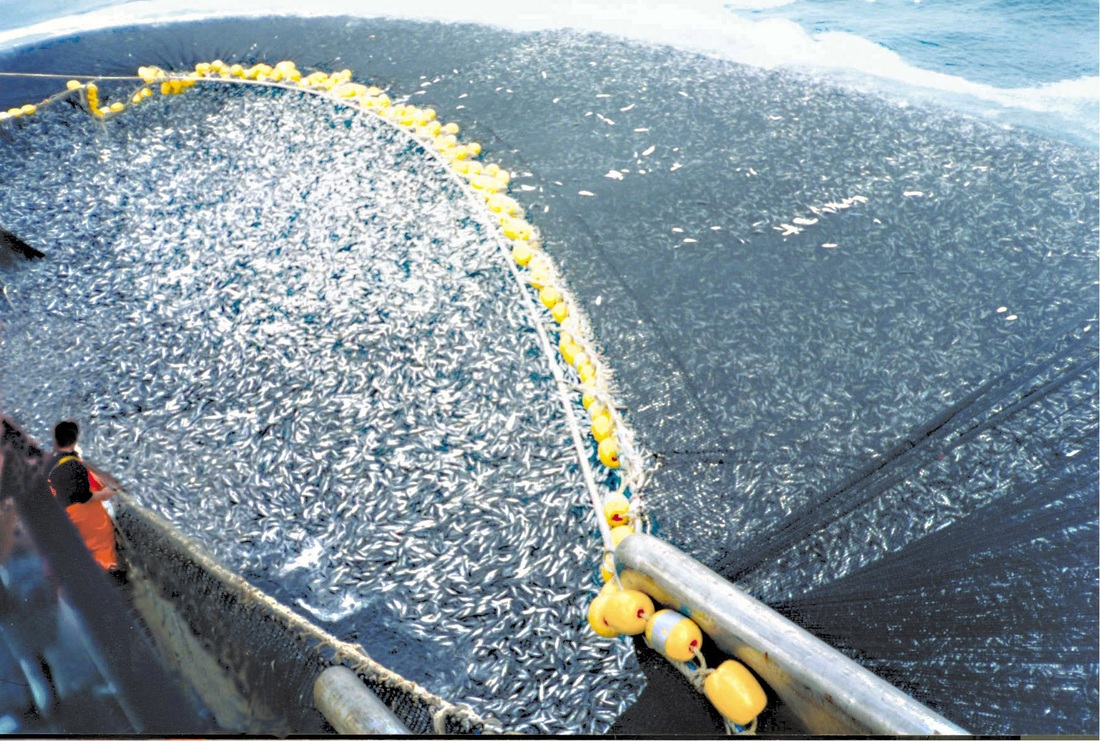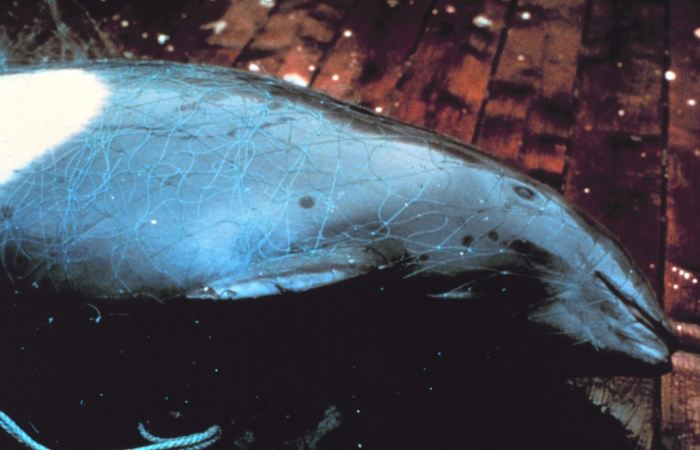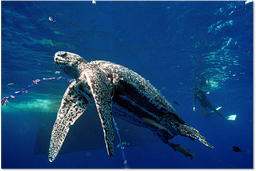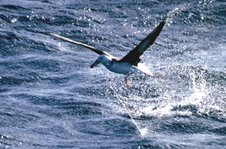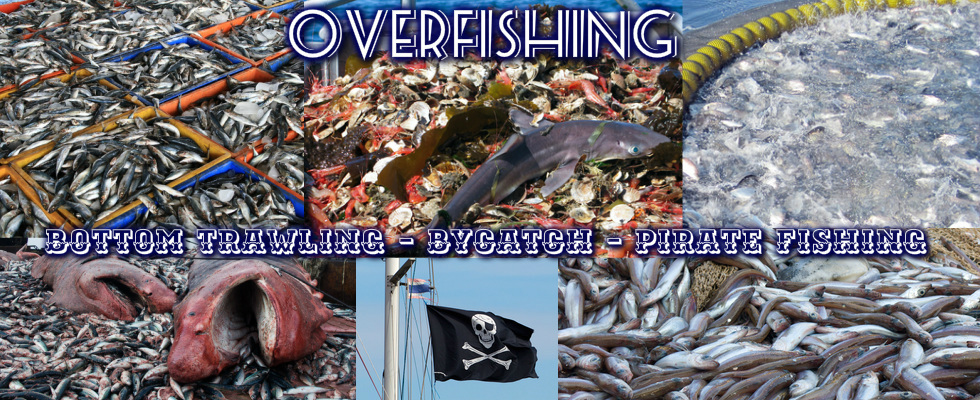
Overfishing
Simply put, overfishing is catching too many fish that the fish cannot sustain their population. This typically continues until the fish become fewer and fewer, until finally there are no more to catch.
Overfishing exceeds the carrying capacity of a fishery by catching so many adult fish that there are not enough remaining to breed and replenish their populations. Historically, the answer to depleting fish stocks was moving to other countries, such as West Africa, which has
long attracted distant fishing fleets from other continents. As global fish stocks continue to plummet, this 'relocation strategy' has increased substantially in recent years finally reaching the present staggering levels where
at least 85% of the world's fish stocks are 'fully exploited,' 'over exploited' or 'depleted', with the Western Indian Ocean and Northeast Atlantic stocks at a level of 100% exploitation. According to the
End of the Line Documentary, "90% of large predatory fish such as tuna, swordfish, sharks, are now gone. 90% of large whales and 60% of the small ones are also now gone from estuaries and coastal waters. 100 million sharks are killed every year. A study done by the Dalhousie University of Canada projects that by 2048 all the species that we fish today extinct." It's easy for people in developed countries to fall victim to the illusion of abundance - to look at the well-stocked, ever-replenishing seafood sections of grocery stores, behold the mountains of fresh, gleaming salmon for sale at outdoor emporiums and explore the plethora of choices on the menus of our finest seafood restaurants and assume that all is well with the world's fish stocks. It's not.
Learn more.
85% of the world's
fish stocks are 'fully exploited', 'over exploited', or 'depleted', with the Western Indian Ocean and Northeast Atlantic stocks at a level of 100% exploitation.
Learn more.
"There are nowhere near enough fish left in the seas to support the armadas of boats going after them and still the industry pushes on. Rather than responding to these warnings and restricting catches in order to allow threatened species to reproduce and recover their numbers, the commercial fleets simply drag, dredge and book one part of the ocean until nothing is left, then move on to new fishing grounds and do the same thing all over again. They’ve done it this way since fishing first became a commercial enterprise, but the curtain is finally closing. There are precious few new grounds left." ~ Ted Danson, Oceana
"90% of large predatory fish such as tuna, swordfish, sharks, are now gone. 90% of large whales and 60% of the small ones are also now gone from estuaries and coastal waters. 100 million sharks are killed every year. A study done by the Dalhousie University of Canada projects that by 2048 all the species that we fish today extinct." ~ End of The Line Documentary
From 1900-2010, the rate of fish extinctions
in North America
skyrocketed to 877 times that found in the fossil record
and with
2.5 times
more fishing capacity in the world than there are fish, North American fish species will soon be going extinct at
twice the rate they are now
.
Learn more.
About 400 tons of jack mackerel (Trachurus murphyi) are caught by a Chilean purse seiner. Click to enlarge | Photo taken by C. Ortiz Rojas | Source: NOAA, Public Domain
"We are in the situation where 40 years down the line we, effectively, are out of fish." ~ Environmental Economist Pavan Sukhdev, UNEP Goodwill Ambassador
"In some parts of the world up to 90% of coastal populations obtain much of their food and earn their primary income through fishing; yet overfishing has reduced some commercial fish stocks by over 90%. More than 275 million people are dependent on coral reefs for food, coastal protection and livelihoods. Globally, coral reef fisheries are worth US$ 6.8 billion annually. Overfishing affects 55% of the world’s reefs. Coral reefs must be managed sustainably to ensure they continue to provide the essential food that millions of people rely on as a source of protein." ~ IUCN, Securing the web of life
"One in five people on this planet depends on fish as the primary source of protein." ~ Food and Agriculture Organization
Bottom Trawling
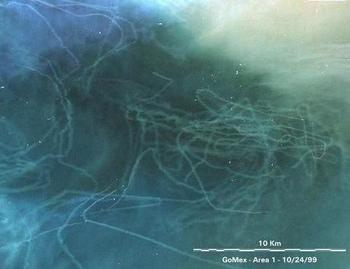
Trawling impacts visible from space. Credit: Landsat | Click to enlarge
Bottom trawls are enormous fishing nets that are literally dragged across the ocean floor, clear-cutting everything living in their path. These trawls are powerful enough to
destroy century old reefs in mere moments
and are often referred to as "ocean bulldozers." According to the
UN, "Bottom trawling accounts for more of the world's catch than any other method. The area trawled each year is about equivalent to 150 times the total forest area clear-cut yearly and corresponds to about an area twice the size of the contiguous United States." Pulverizing everything in their path, crushing deep coral, grinding boulders to mere rubble, wiping out populations of fish and other creatures and leaving behind a flat, featureless moonscape of gravel and sand, bottom trawls are the underwater scourge of the ocean. The mouths of the largest trawling nets are
big enough to fit a Boeing 747 Jumbo Jet, can reach lengths of 1.5 football fields and destroy 580 square miles of seabed each day. According to
Oceana, "European scientists have calculated that bottom-dragging trawlers in the North Sea destroy 16 pounds of marine animals for every pound of marketable sole that is caught." Moreover, as these trawling nets are dragged across the ocean floor,
silt clouds of up to 17 miles in diameter are created causing major destruction and even changing the chemistry of the water itself.
These silt clouds can be seen from space
and release pollutants trapped in the seafloor mud, which can enter and clog the breathing and feeding systems of all kinds of marine life, from sea turtles to coral polyps.
It can take decades or even centuries for a seabed to recover from a single pass of a bottom trawl net.
Learn more.
"If allowed to continue, the bottom trawlers of the high seas will destroy deep sea species, before we have even discovered much of what is out there. Think of it as driving a huge bulldozer through an unexplored, lush and richly populated forest and being left with a flat, featureless desert. It's like blowing up Mars before we get there." ~ Greenpeace
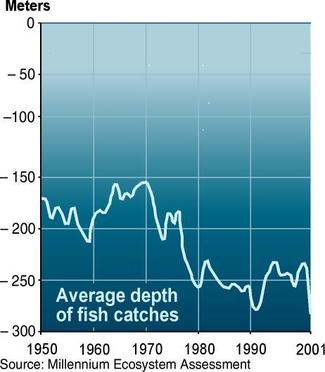
Trend in mean depth of catch since 1950. Fisheries catches increasingly originate from deep areas. Over the years due to depletion in fish stocks the fishing industry has resorted to fishing at greater depths and increasing the damage to fish stocks and the ocean floor. Click for source.
"We’re eating today what our grandparents used as bait." ~
Ted Danson, Oceana
Types of fishing gear used in U.S. fisheries
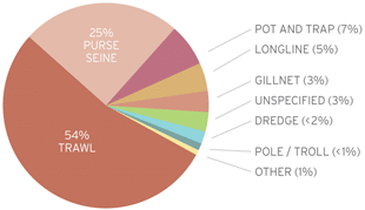
Most seafood in the U.S. is caught using nets dragged behind boats, such as purse seines, trawls and dredges. Source: NMFS, 2009 | Click to learn more
In May 2007, a group of 125 scientists from 27 countries issued a warning
to the world about the perils of global overfishing and the need to act: "There is no longer any question – we have reached a critical state. The world’s ocean ecosystems are at a tipping point, and overfishing represents one of the greatest threats to their productivity... There are only decades left before the damage we have inflicted on the oceans becomes permanent. We are at a crossroads. One road leads to a world with tremendously diminished marine life. The other leads to one with oceans again teeming with abundance, where the world can rely on the oceans for protein, and enjoy its wildlife. The choices we make today will determine our path for the future."
"After climate change, commercial fishing represents the greatest threat to life in our oceans. As well as ruthlessly fishing out stock after stock, the way we fish has disastrous consequences for other species and entire ecosystems – but the damage being done is out at sea, out of sight, and out of mind for most people. We need to take drastic action to repair the damage we’ve done to our oceans before it’s too late." ~ Willie Mackenzie, Greenpeace
By-Catch
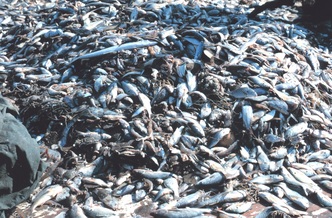
Shrimp by-catch. Source: NOAA, Public Domain | Click to enlarge
Many fisheries
catch unwanted fish other than the species that they target
and
throw away more fish than they keep. Whether dead or dying,
billions of unwanted marine creatures
caught in the fishing nets are simply tossed back into the sea as by-catch, which is widely recognized as one of the
most serious environmental impacts of modern commercial fisheries. Estimates range from
eight percent to one quarter
of the total global catch being discarded as by-catch, with the most destructive fisheries, such as trawl fisheries for shrimp,
discarding up to 90% of their catch
or
up to six pounds of other species for every pound of shrimp caught. By-catch is often caused by longlines, which can
extend for 50 miles or more and attract anything that swims by, from sharks to albatrosses to sea turtles, and bottom trawls, which drag nets across the seafloor, catching and destroying everything in their paths. According to
WWF, over 300,000 small whales, dolphins, and porpoises die from entanglement in fishing nets each year as by-catch, as many as 250,000 endangered loggerhead turtles and critically endangered leatherback turtles are caught annually on longlines intended for other species, 26 species of seabird are threatened with extinction because of longlining, 89% of hammerhead sharks and 80% of thresher and white sharks have disappeared from the Northeast Atlantic Ocean in the last 18 years largely due to by-catch, shrimp trawlers unintentionally catch as many as 35 million juvenile red snappers each year in the Gulf of Mexico as by-catch, and billions of corals, sponges, starfish, and other invertebrates are caught as bycatch every year. Anywhere between
6.8 million and 27 million tons of fish could be being discarded each year, but there's no way of knowing for sure how many marine creatures are maimed or killed by fishing nets or hooks that never get hauled up or accurately recorded in by-catch numbers, since after all, there is usually no one there to watch. What we do know is the reported totals of discarded fish are egregiously inaccurate.
Discover and Support Solutions to By-Catch
"Hundreds of thousands of sea turtles, seabirds and marine mammals, including whales, dolphins and porpoises, die as bycatch. As many as 200,000 loggerhead sea turtles and 50,000 leatherback sea turtles are caught annually. Longline fishing also kills hundreds of thousands of seabirds when they become entangled in driftnets or caught on longline hooks when they dive for bait. Nearly 20 percent of shark species are threatened with extinction, primarily as a result of being caught accidentally on longlines. Bycatch also includes young fish that could rebuild populations if they were allowed to grow and breed." ~ Monterey Bay Aquarium
UK Trawler Filmed Dumping Tons of By-Catch
Source: Norway government coastguard: Video Capture Image. Click to watch.
Source: Norway government coastguard: Video Capture Image. Click to watch.
"For every pound of seafood that goes to market, more than 10 pounds, even 100 pounds, may be thrown away as by-catch." ~ Sylvia Earle
"With so many fish, including juvenile fish, being wastefully discarded, bycatch is contributing to the global problem of overfishing and declining marine ecosystem health, and endangering food security in poorer countries." ~ WWF
Watch
Gordon Ramsey eat shark fin soup
to learn why one of the greatest threats sharks face is the cultural value of their fins! Then,
discover why sharks are more valuable in the ocean than in the soup pot.
Shark finning
is responsible for the death of between
88 million to 100 million sharks
every year.
Discover the
Status of the Shark
and
What Would Happen if Sharks Disappeared.
Pirate Fishing
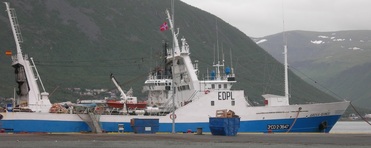
Trawler arrested for illegal fishing. Wikipedia Commons | Click to enlarge
Pirate fishing, also known as Illegal, Unreported and Unregulated fishing (IUU) is the hidden plague of the fisheries industry, significantly affecting the marine environment, coastal countries and communities, and sustainable fisheries. Pirate fishing accounts for an
estimated 20% of the world’s catch and up to 50% of the catch in some fisheries,
robbing communities of much needed food and income, leaving the marine environment degraded and empty, distorting global markets by artificially
driving prices down
and
undermining legitimate competition. According to
WWF, "The costs of pirate fishing are significant, with the value of pirate fish products estimated at between $10-23.5 billion annually. This is a major loss of income to coastal countries and communities. This is especially the case for some of the world's poorest countries, which depend on fishing for food, livelihoods and revenues." Operating virtually off the radar of any enforcement, these poachers use
flags of convenience (FoC)
to pose as legitimate fishing vessels for any given country,
kill tens of thousands of marine animals as bycatch, destroy fragile marine habitats through their unregulated use of damaging, often illegal, fishing practices, and often disguise the origin of their illegal catch to sell legitimately into consumer markets, mainly to developed countries, such as
Japan, the European Union and the United States.
Learn more.
"In the human body,
fish accounts for approximately one-fifth of all animal protein intakes. Studies show that roughly one billion people depend on fish as their primary source of protein." ~
Richard Ellis
72,000 fishing jobs have been lost in the Pacific Northwest alone because of declining salmon stocks. Learn more.
72,000 fishing jobs have been lost in the Pacific Northwest alone because of declining salmon stocks. Learn more.
"In the past four decades cod have been so overfished that current quotas are just one-tenth what they were in the 1970s." ~ Treehugger

